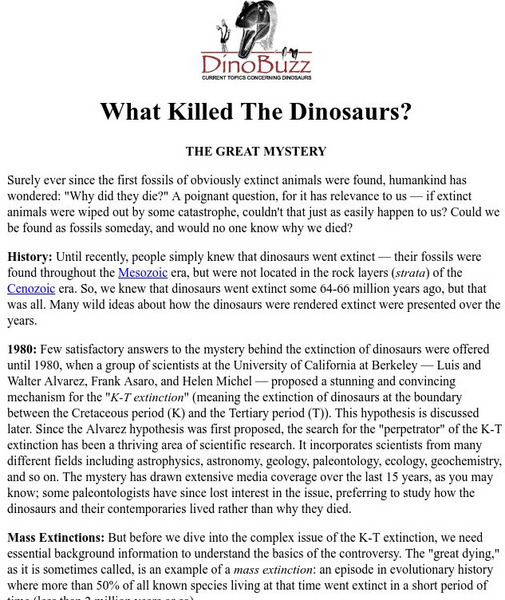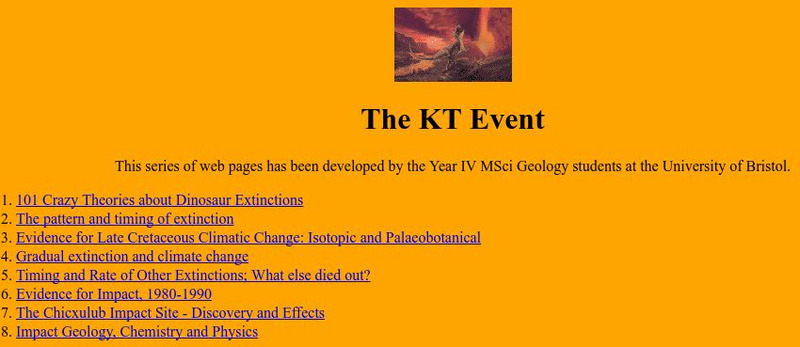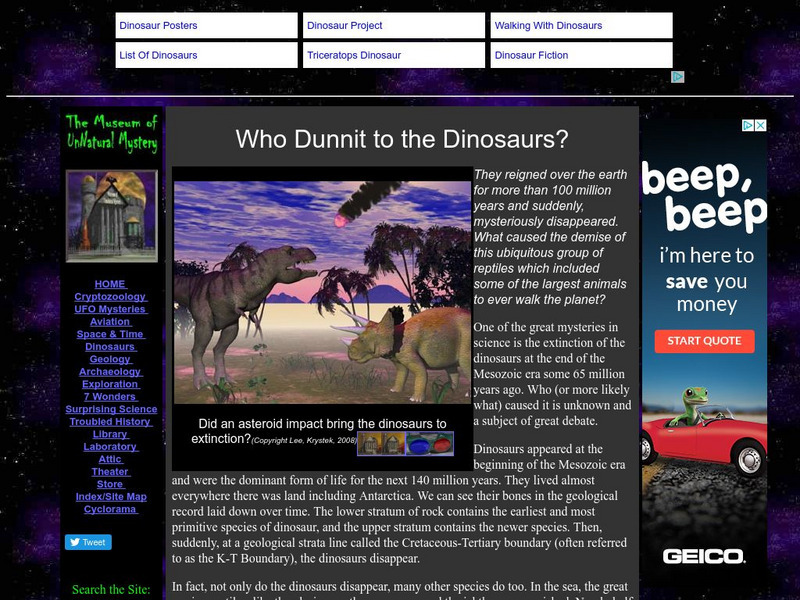Hi, what do you want to do?
Curated OER
The Lost World (4 parts)
Tenth graders view this science fiction adventure, though not scientifically accurate, creates opportunities to explore the extinction of dinosaurs and to explore evolution.
Curated OER
Steppin' Out: Using Inquiry to Challente Alexander's Stride Analysis
Students distinguish between walking, jogging and running trackways in humans. They analyze the phylogenetic progression of the leg position as described by pace width and angulation, comparing amphibians, reptiles and mammals. Research...
Curated OER
Morphing
Students examine how organisms adapt to their environment in order to survive. As a class, they discuss the extinction of the dinosaurs and review Darwin's theory of survival of the fittest. They select an animal to morph in the future...
Curated OER
Living Fossils
Middle schoolers study the term living fossil and examine why some of the reasons they survived. For this fossils lesson students form a hypothesis and use data to see if it is accurate.
Curated OER
Fossil Hunters!
Students explore the various ways in which geologists create fossil records. Working in pairs, students create a model of a fossil record through a hands on activity. They relate their experience to recent discoveries in geology and...
Curated OER
Tsunami
Learners examine what causes tsunamis and why they all behave differently. In this tsunami lesson students complete a group activity after viewing a video.
Curated OER
Animals
Second graders discuss the term "endangered". They identify the reasons some animals are in danger of being wiped out. They discover ways humans can help the species survive.
Curated OER
Doing Science: Computer Models
In this computer models worksheet, students read information about how scientists use computer models to advance the work of science. Students also answer a critical thinking question comparing computer simulations to direct observations.
Virginia Tech
Virginia Polytechnic Institute: Greenhouse Dinosaur Extinction Theory
This comprehensive page discusses the Asteroid Impact vs. Volcano-Greenhouse dinosaur extinction debate. It was written by paleontologist, professor, and scientist Dr. Dewey McLean.
University of California
Ucmp: What Killed the Dinosaurs?
This UC Berkeley site extensively covers the death of the dinosaurs. It includes history, theories, invalid hypotheses, and current arguments.
Utah Education Network
Uen: Trb 4:4 Investigation 6 Dinosaur Extinction
Research and analyze theories on why dinosaurs became extinct.
Other
University of Chicago: Dinosaur Extinction
This theory from the University of Chicago of dinosaur extinction revolves around the concept of plate tectonics, the movement of the continents over a sort of liquid around the planet.
PBS
Pbs Learning Media: What Killed the Dinosaurs?
This Evolution Web feature explores how evidence can support a variety of hypotheses surrounding the mystery behind the extinction of the dinosaurs.
Other
Dinosaur Extinction: One More Hypothesis
"The survivals and extinctions at the close of the Cretaceous are such as might be expected to result from intensely hot winds such as would be generated by extra large meteoritic impacts." This article suggests that this theory should...
Other
University of Bristol: The Kt Event
This dinosaur site, containing eight different sections, includes topics such as: 101 crazy theories about dinosaur extinction, the pattern and timing of extinction, evidence for late cretaceous climatic change, gradual extinction and...
Center for Educational Technologies
Earth Science Explorer: Dinosaur Floor
Take a tour of the dinosaur floor and you'll read several theories about why dinosaurs became extinct.
SEDL
Sedl: Extinction
This second lesson in a course on dinosaurs is devoted to extinction. There are group activities, discussion of the idea, and a way to assess what the students have learned.
Enchanted Learning
Enchanted Learning: Zoom Dinosaurs
Zoom Dinosaurs is a comprehensive on-line hypertext book about dinosaurs. It is designed for students of all ages and levels of comprehension. It has an easy-to-use structure that allows readers to start at a basic level on each topic,...
BBC
Bbc: Rise and Fall of the Dinosaurs
Several articles that trace the chronology of the dinosaur from the Triassic to the Cretaceous. Articles were written to accompany the BBC series, Walking with Dinosaurs.
Other
Dinosaur Facts
There is plenty of information about dinosaurs here for students doing research. There are a fair number of ads but they are mainly related to dinosaurs. Besides fact pages for hundreds of dinosaurs, you will find information about...
Other
Canal Kids: Dinossauros (Dinosaurs), a Era Dos Gigantes
A good introduction to dinosaurs for young Portuguese-speaking children. Uses an engaging writing style, cartoon-style graphics, and animation to teach about the Mesozoic era. Coverage includes types of dinosaurs and their features,...
Other
Scientists Say Star Collision Caused Dinosaur Extinction
"Israeli scientists have a new theory on why the dinosaurs became extinct: cosmic radiation that bombarded the Earth following the collision of two neutron stars." This article discusses the details of the theory.
Other
Who Dunnit to the Dinosaurs?
"One of the great mysteries in science is the extinction of the dinosaurs at the end of the Mesozoic Era some 65 million years ago. Who (or more likely what) caused it is unknown and a subject of great debate." Many theories are touched...
University of California
Ucmp: The Dinosauria
The Dinosauria provides the latest information about dinosaurs, including debunking myths, early dinosaur discoveries, characteristics of specific dinosaurs, life history, and discovery of dinosaur fossils.
























